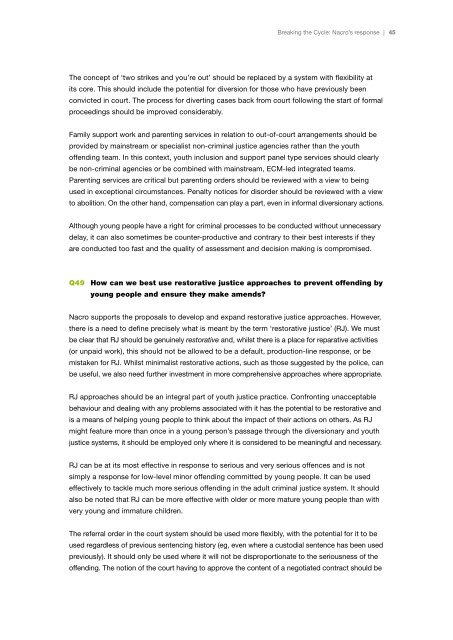Nacro's response to Breaking the Cycle Green Paper
Nacro's response to Breaking the Cycle Green Paper
Nacro's response to Breaking the Cycle Green Paper
Create successful ePaper yourself
Turn your PDF publications into a flip-book with our unique Google optimized e-Paper software.
<strong>Breaking</strong> <strong>the</strong> <strong>Cycle</strong>: Nacro’s <strong>response</strong> | 45The concept of ‘two strikes and you’re out’ should be replaced by a system with flexibility atits core. This should include <strong>the</strong> potential for diversion for those who have previously beenconvicted in court. The process for diverting cases back from court following <strong>the</strong> start of formalproceedings should be improved considerably.Family support work and parenting services in relation <strong>to</strong> out-of-court arrangements should beprovided by mainstream or specialist non-criminal justice agencies ra<strong>the</strong>r than <strong>the</strong> youthoffending team. In this context, youth inclusion and support panel type services should clearlybe non-criminal agencies or be combined with mainstream, ECM-led integrated teams.Parenting services are critical but parenting orders should be reviewed with a view <strong>to</strong> beingused in exceptional circumstances. Penalty notices for disorder should be reviewed with a view<strong>to</strong> abolition. On <strong>the</strong> o<strong>the</strong>r hand, compensation can play a part, even in informal diversionary actions.Although young people have a right for criminal processes <strong>to</strong> be conducted without unnecessarydelay, it can also sometimes be counter-productive and contrary <strong>to</strong> <strong>the</strong>ir best interests if <strong>the</strong>yare conducted <strong>to</strong>o fast and <strong>the</strong> quality of assessment and decision making is compromised.Q49 How can we best use res<strong>to</strong>rative justice approaches <strong>to</strong> prevent offending byyoung people and ensure <strong>the</strong>y make amends?Nacro supports <strong>the</strong> proposals <strong>to</strong> develop and expand res<strong>to</strong>rative justice approaches. However,<strong>the</strong>re is a need <strong>to</strong> define precisely what is meant by <strong>the</strong> term ‘res<strong>to</strong>rative justice’ (RJ). We mustbe clear that RJ should be genuinely res<strong>to</strong>rative and, whilst <strong>the</strong>re is a place for reparative activities(or unpaid work), this should not be allowed <strong>to</strong> be a default, production-line <strong>response</strong>, or bemistaken for RJ. Whilst minimalist res<strong>to</strong>rative actions, such as those suggested by <strong>the</strong> police, canbe useful, we also need fur<strong>the</strong>r investment in more comprehensive approaches where appropriate.RJ approaches should be an integral part of youth justice practice. Confronting unacceptablebehaviour and dealing with any problems associated with it has <strong>the</strong> potential <strong>to</strong> be res<strong>to</strong>rative andis a means of helping young people <strong>to</strong> think about <strong>the</strong> impact of <strong>the</strong>ir actions on o<strong>the</strong>rs. As RJmight feature more than once in a young person’s passage through <strong>the</strong> diversionary and youthjustice systems, it should be employed only where it is considered <strong>to</strong> be meaningful and necessary.RJ can be at its most effective in <strong>response</strong> <strong>to</strong> serious and very serious offences and is notsimply a <strong>response</strong> for low-level minor offending committed by young people. It can be usedeffectively <strong>to</strong> tackle much more serious offending in <strong>the</strong> adult criminal justice system. It shouldalso be noted that RJ can be more effective with older or more mature young people than withvery young and immature children.The referral order in <strong>the</strong> court system should be used more flexibly, with <strong>the</strong> potential for it <strong>to</strong> beused regardless of previous sentencing his<strong>to</strong>ry (eg, even where a cus<strong>to</strong>dial sentence has been usedpreviously). It should only be used where it will not be disproportionate <strong>to</strong> <strong>the</strong> seriousness of <strong>the</strong>offending. The notion of <strong>the</strong> court having <strong>to</strong> approve <strong>the</strong> content of a negotiated contract should be
















